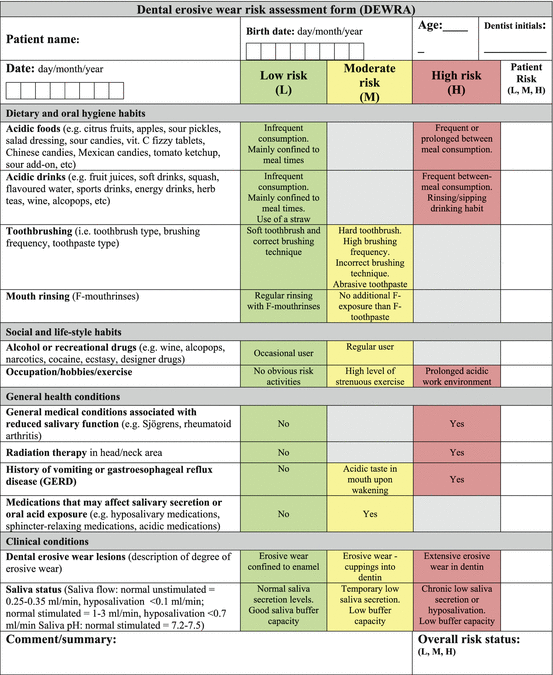Score
0
No erosive tooth wear
1
Initial loss of surface texture
2
Distinct defect, hard tissue loss <50 % of the surface area
3
Hard tissue loss ≥50 % of the surface area
The erosion risk status can be determined with the Dental erosive wear risk assessment (DEWRA) form (Table 16.2) developed by Young et al. [2] and described in detail in Chap. 7 of this book [2]. With DEWRA, the patient’s responses to more in-depth history-taking regarding dietary and oral hygiene habits, social and lifestyle habits, general health conditions, together with a detailed clinical recording of erosive wear lesions using the BEWE or other scoring system, guide the practitioner to assign the patient to low, medium, or high risk status categories. The risk status of the patient guides the practitioner’s recommendations for the management of the condition, which includes the recall interval for review and monitor. The DEWRA guidance indicates that the frequency range for recall could be as high as once every 6 months for patients at high risk of developing erosive tooth wear, to a low of once every 2 years for those at low risk of developing erosion. Thus the DEWRA recommends that patient with erosive tooth wear should be reviewed and monitored as follows:

Table 16.2
Dental erosive wear risk assessment (DEWRA) form [2]

-
Low risk – every 18–24 months
-
Moderate risk – every 6–12 months
-
High risk – every 6 months
It is important to mention that the same risk assessment tool used for the initial risk status assessment should be used for reassessment at each subsequent recall visit. The above recommended recall interval accords with that of the BEWE, which depends on the severity level of the lesion. With BEWE, the dentition is divided into sextants and the most severely affected surface in a sextant is recorded. The sum of the scores of the six sextants constitutes the index value, which guides the management of the condition, including the recall interval (Table 16.3).
Table 16.3
Complexity levels as a guide to clinical management, from Bartlett et al. [5]
|
Complexity level
|
Cumulative score of all sextants
|
Management
|
|---|---|---|
|
0
|
Less than or equal to 2a
|
• Routine maintenance and observation
• Repeat at 3-year intervals
|
|
1
|
Between 3 and 8a
|
• Oral hygiene and dietary assessment, advice, routine maintenance, and observation.
• Repeat at 2-year intervals
|
|
2
|
Between 9 and 13a
|
• Oral hygiene and dietary assessment, advice, identify the main aetiological factor(s) for tissue loss, and develop strategies to eliminate respective impacts
• Consider fluoridation measures or other strategies to increase the resistance of tooth surfaces
• Ideally, avoid the placement of restorations and monitor erosive wear with study casts, photographs, or silicone impressions
• Repeat at 6–12 month intervals
|
|
3
|
14 and overa
|
• Oral hygiene and dietary assessment, advice, identify the main aetiological factor(s) for tissue loss, and develop strategies to eliminate respective impacts
• Consider fluoridation measures or other strategies to increase the resistance of tooth surfaces
• Ideally, avoid restorations and monitor tooth wear with study casts, photographs, or silicone impressions
• Especially in cases of severe progression consider special care that may involve restorations
• Repeat at 6–12 month intervals
|
In general, recommended interval between oral health reviews should be determined specifically for each patient and tailored to meet his or her needs. Besides patient’s erosion severity levels and erosion risk status, recall intervals may be influenced by whether it is for review and monitor of overall risk management, for assessing preventive interventions, for monitoring of the progression status of existing erosion lesions, or for reviews of behavioral and lifestyle modification plans. Interval should be set with the clinical judgment and expertise of the dental team. The recall interval should be chosen either on completion of a specific treatment journey or at the end of an oral health review if no further treatment is indicated [7]. The dentist should discuss the recommended recall interval with the patient and the patient’s agreement or disagreement with it should be sought. This discussion should involve consideration to the patient’s ability or desire to visit the dentist at the recommended interval, the financial costs to the patient of having such review visits and any subsequent treatments, and other possible impediments to the patient’s compliance to this review interval [8]. It is important to inform the patient that his/her recall interval may change from time to time subject to change in his/her erosion risk status.
16.3 Activities at the Recall Visit
The activities that the practitioner has to perform at the next oral health review for his/her patient suffering from erosive tooth wear should consist of review, monitor, synthesis, and health outcomes analysis as described below.
16.3.1 Review
At every recall visits, the patient’s compliance with the behavior modifications recommended and discussed in regards to the erosion risk management plan should be evaluated. The behavioral modification counseling at each review visit should continue to be offered by motivational interviewing. Motivational interviewing is a patient-centered method for enhancing intrinsic motivation to change by exploring and resolving ambivalence. Individuals assess their own behaviors, present arguments for change, and decide what behavior to focus on while the counselor helps to create an acceptable resolution that triggers change [9–11]. The goals of the behavior modification should be revisited, considered, and discussed motivationally as necessary. Besides evaluating the status of recommended behavioral changes, patient’s perception of value of oral health and treatment choices should be assessed. It may be necessary for the patient to receive an individualized letter of advice, listing the newly designed behavior modification goals for the patient to take home. Future behavior goals may need to be developed and recorded at this stage.
16.3.2 Monitor
Stay updated, free dental videos. Join our Telegram channel

VIDEdental - Online dental courses


